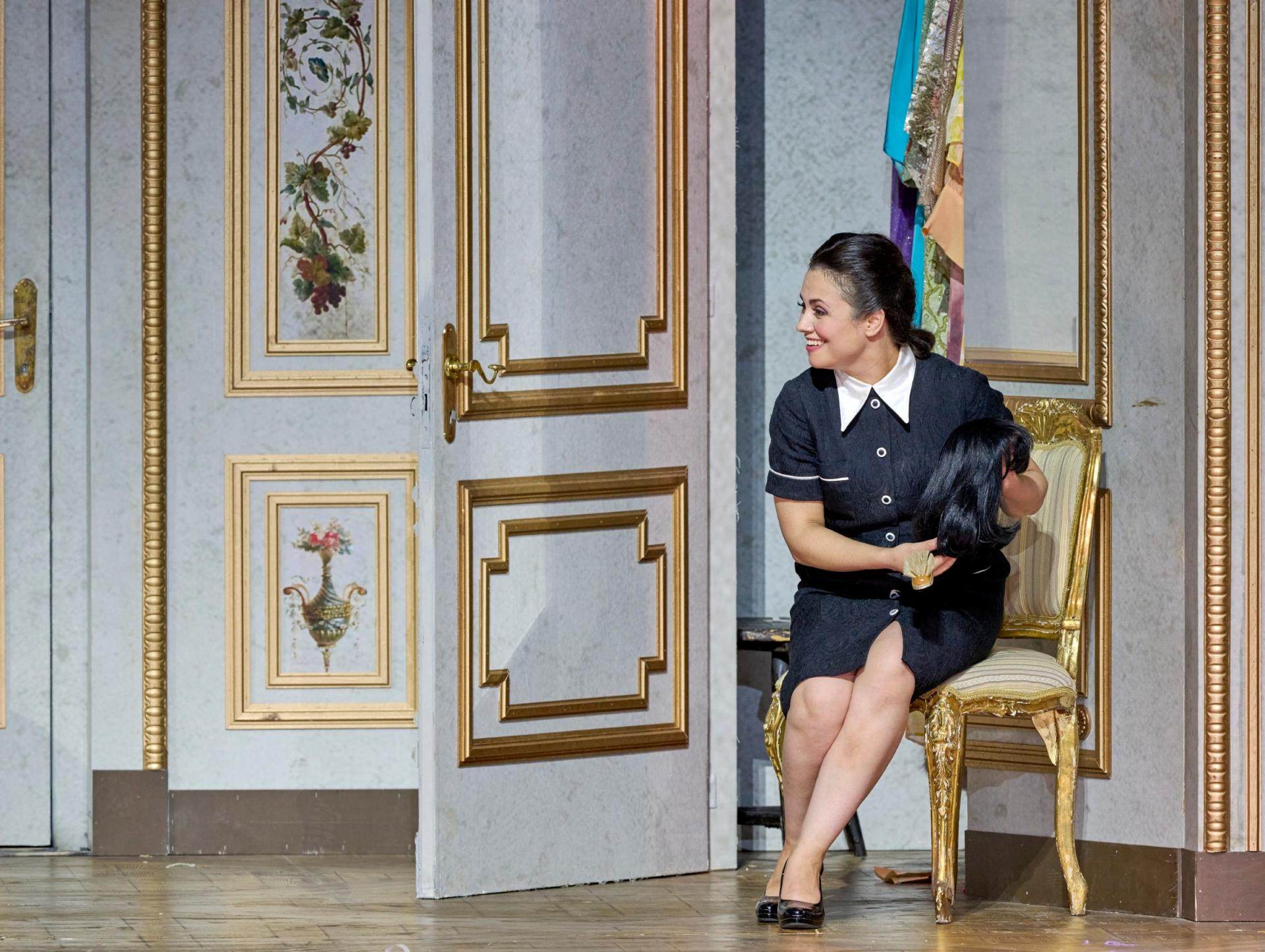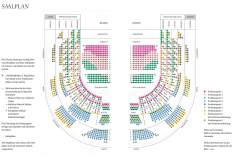The Marriage of Figaro
Mo | Tu | We | Th | Fr | Sa | Su |
Wolfgang Amadeus Mozart's Le nozze di Figaro - one of the most popular and most frequently performed works at the Vienna State Opera - tells of a "great day": An exceptional work in terms of music, the congenial based on the libretto by Lorenzo Da Ponte .
ACT 1
Figaro and Susanna, the countess’s maid, want to get married. Susanna explains to her unsuspecting fiancé why their new bedroom is situated directly between the count’s room and that of the countess: so that the count will have easier access to her, for Almaviva is looking for a little extramarital adventure. As a progressive lord of the manor, he abolished the old right of the first night, but would like to reinstate it in Susanna’s case. Figaro has another problem: some time ago, he borrowed money from Marcellina and promised her in writing that he would marry her if he was unable to repay the debt. Aided by Doctor Bartolo, Marcellina now wants to compel him to live up to his agreement. The count has surprised the page Cherubino alone with Barbarina, the palace gardener’s daughter, to whom the count himself pays occasional visits. Cherubino, whom the count
dismissed from his service on the spot, relates his woes to Susanna. He wants the countess, whom he admires ardently, to intercede with the count on his behalf. Count Almaviva enters unexpectedly, Cherubino hides quickly, and the Count to starts
fervently in protest his affections. They are interrupted by Basilio. The count himself is forced to hide. Basilio tries to interest Susanna in a liaison with the count. He also mentions the rumours about Cherubino’s passionate love for the countess. Incensed, Almaviva bursts from his hiding place and relates, with wild gesticulations, how he surprised Cherubino recently with the gardener’s daughter. To his astonishment, he discovers Cherubino here too, but must stifle his wrath since the page must have overheard everything from his hiding place.
Figaro arrives with all the servants to persuade the count finally in give his consent to the wedding. Almaviva promises to give it – later. Cherubino is pardoned only the extent that he is to leave at once and joint the count’s regiment as an officer.
ACT 2
Countess Rosina feels neglected by her husband and turns to Susanna and Figaro for help. Figaro has come up with two plans: he intends to provoke the count’s jealousy with an anonymous letter, thereby making him forget about Susanna. In addition, Cherubino, disguised as Susanna, is to make an assignation with the count in the palace garden, where Figaro will surprise him in a compromising situation and expose him. Cherubino is trying on girl’s clothes in the countess’s room. The count appears
unexpectedly; the countess and Susanna hide the page in the dressing-room. The suspicious count demands the key to the locked room, and the two of them finally go off to fetch tools to break open the door. Meanwhile, Susanna lets Cherubino out of the
dressing-room, who in his fright leaps out of the window. On their return the countess confesses to her husband that Cherubino is in the dressing-room. To the amazement of both count and countess, Susanna steps out of the dressing-room, and the count must apologize to his wife. To exonerate themselves, the countess and Susanne admit to the count that the anonymous letter was written by Figaro and was a trick. Figaro unwillingly confirms this to be the case. Now the irate gardener enters and tells his master that someone jumped out of the countess’s bedroom window and broke a flower pot – and lost an officer’s commission. All that was missing was the count’s seal. Marcellina and Doctor Bartolo appear and demand that Figaro comply with his contract. The count once again puts off giving his consent to the wedding.
ACT 3
Susanna wants no find the money Figaro owes and accordingly agrees to a clandestine meeting with the count. However, he chances to notice that Susanna intends to deceive him and so confirms the judge’s decision: Figaro must pay – or marry Marcellina. In the ensuring argument, it turns out that Figaro, who did not know his parents, is the son of Doctor Bartolo and Marcellina, the product of an earlier affair between the two. The happy reunion of parents and son is initially misunderstood by Susanna, who has in the meantime been given the necessary money by the countess. However, the matter is soon cleared up.
Countess Rosina and Susanna have come up with their own plan: without Figaro’s knowledge, they write a letter to the count, asking him to meet Susanna that night in the palace park; however, in reality the countess, disguised as Susanna, will be waiting for him. Cherubino did not go to join his regiment, but sought refuge with Barbarina. When he takes part in the festivities dressed as a girl, Barbarina’s father exposes him. The count sees a final opportunity to delay the wedding, but Barbarina threatens to reveal the nature of the count’s relationship with her. Now the wedding can finally take place. But the folly has not yet ended: as they dance, Susanna gives the count the fake love letter.
ACT 4
The letter to the count was sealed with a pin that he was to give to Susanna as a sign of his agreement. Barbarina has lost the pin and now searches for it desperately. Figaro finds out about the planned rendezvous; since he was not party to this plan, he is
outraged at his fiancée Susanna’s unfaithfulness. Confusion reigns that night in the palace park. The count waits for Susanna, who has switched clothes with the countess. Figaro, his parents and Basilio intend to catch the count in flagrante delicto and expose him. To this end they have alerted the entire staff of servants. In the midst of all this, Cherubino seeks his Barbarina. One case of mistaken identity follows another. Finally Figaro realizes what is happening. He makes love to the apparent countess (in reality Susanna in disguise) so that the count cannot but overhear the conversation. The count surprises the two of them, summons everyone and publicly accuses the “countess” of being unfaithful. The others gradually come out of hiding. Finally the real countess appears, still in Susanna’s dress, and reveals her identity. Count Almaviva begs his wife’s forgiveness. The countess has achieved the purpose of her intrigue, forgives her husband, and all those present celebrate the happy ending to this
“day of folly”.
Program and cast
Season 23/24
Graf Almaviva: Davide Luciano
Gräfin Almaviva: Federica Lombardi
Susanna: Slávka Zámečníková
Figaro: Philippe Sly
Cherubino: Isabel Signoret
Marcellina: Stephanie Houtzeel
Basilio: Norbert Ernst
Don Curzio: Andrea Giovannini
Bartolo: Evgeny Solodovnikov
Antonio: Attila Mokus
Barbarina: Daria Kolisan
Musical Direction: Philippe Jordan
Production: Barrie Kosky
Stage: Rufus Didwiszus
Costumes: Victoria Behr
Lighting: Franck Evin
Stage Assistant: Jan Freese
Season 24/25
Graf Almaviva: Andrè Schuen; Leonardo Neiva*
Gräfin Almaviva: Hanna-Elisabeth Müller
Susanna: Slávka Zámečníková
Figaro: Peter Kellner; Philippe Sly*
Cherubino: Isabel Signoret; Patricia Nolz*
Musical Direction: Ivor Bolton; Philippe Jordan*
Production: Barrie Kosky
Stage: Rufus Didwiszus
Costumes: Victoria Behr
Lighting: Franck Evin
Stage Assistant: Jan Freese
*March 29, 2025 & April 2, 202
Vienna State Opera
Public Transport
Subway lines: U1, U2, U4
Trams: 1, 2, D, J, 62, 65
Buses: 59A
Local Railway: Badner Bahn
Stops: Karlsplatz / Opera
Taxi stands are available nearby.
Parking
Parking is only € 6, - for eight hours!
The Wiener Staatsoper and the ÖPARK Kärntner Ring Garage on Mahlerstraße 8, under the “Ringstraßengalerien”, offer the patrons of the Vienna State Opera a new, reduced parking fee. You can park in the Kärntner Ring Garage for up to 8 hours and pay only a flat fee of € 6, -. Just validate your ticket at one of the discount machines inside the Wiener Staatsoper. The normal rate will be charged for parking time greater than 8 hours. The validation machines can be found at the following coat checks: Operngasse, Herbert von Karajan-Platz, and the right and left and balcony galleries.
Important: In order to get the discount, please draw a ticket and do not use your credit card when entering the garage!
After devaluing your ticket in the Wiener Staatsoper you can pay comfortably by credit card or cash at the vending machines.
The machines accept coins and bills up to 50.- Euro. Parking time longer than 8 hours will be charged at the normal rate.
History
The structure of the opera house was planned by the Viennese architect August Sicard von Sicardsburg, while the inside was designed by interior decorator Eduard van der Nüll. It was also impacted by other major artists such as Moritz von Schwind, who painted the frescoes in the foyer, and the famous "Zauberflöten" (“Magic Flute”) series of frescoes on the veranda. Neither of the architects survived to see the opening of ‘their’ opera house: the sensitive van der Nüll committed suicide, and his friend Sicardsburg died of a stroke soon afterwards.
On May 25, 1869, the opera house solemnly opened with Mozart's Don Giovanni in the presence of Emperor Franz Joseph and Empress Elisabeth.
The popularity of the building grew under the artistic influence of the first directors: Franz von Dingelstedt, Johann Herbeck, Franz Jauner, and Wilhelm Jahn. The Vienna opera experienced its first high point under the direction of Gustav Mahler. He completely transformed the outdated performance system, increased the precision and timing of the performances, and also utilized the experience of other noteworthy artists, such as Alfred Roller, for the formation of new stage aesthetics.
The years 1938 to 1945 were a dark chapter in the history of the opera house. Under the Nazis, many members of the house were driven out, pursued, and killed, and many works were not allowed to be played.
On March 12, 1945, the opera house was devastated during a bombing, but on May 1, 1945, the “State Opera in the Volksoper” opened with a performance of Mozart's THE MARRIAGE OF FIGARO. On October 6, 1945, the hastily restored “Theaters an der Wien” reopened with Beethoven's FIDELIO. For the next ten years the Vienna State Opera operated in two venues while the true headquarters was being rebuilt at a great expense.
The Secretary of State for Public Works, Julius Raab, announced on May 24, 1945, that reconstruction of the Vienna State Opera would begin immediately. Only the main facade, the grand staircase, and the Schwind Foyer had been spared from the bombs. On November 5, 1955, the Vienna State Opera reopened with a new auditorium and modernized technology. Under the direction of Karl Böhm, Beethoven’s FIDELIO was brilliantly performed, and the opening ceremonies were broadcast by Austrian television. The whole world understood that life was beginning again for this country that had just regained its independence.
Today, the Vienna State Opera is considered one of the most important opera houses in the world; in particular, it is the house with the largest repertoire. It has been under the direction of Dominique Meyer since September 1, 2010.

 EN
EN DE
DE IT
IT FR
FR ES
ES RU
RU JP
JP RO
RO
 Seating plan
Seating plan